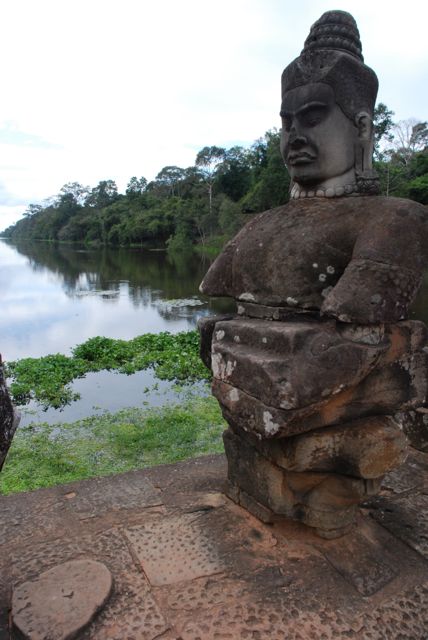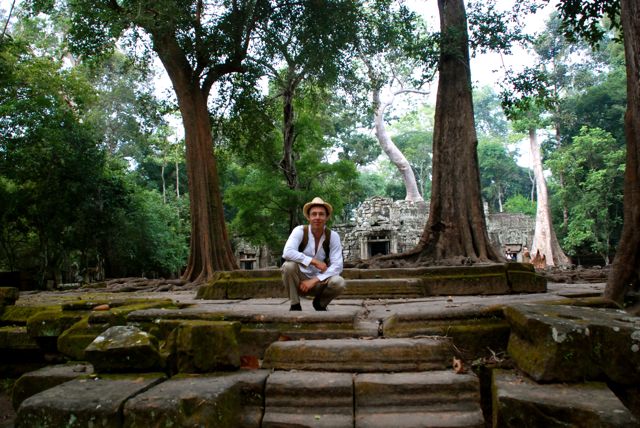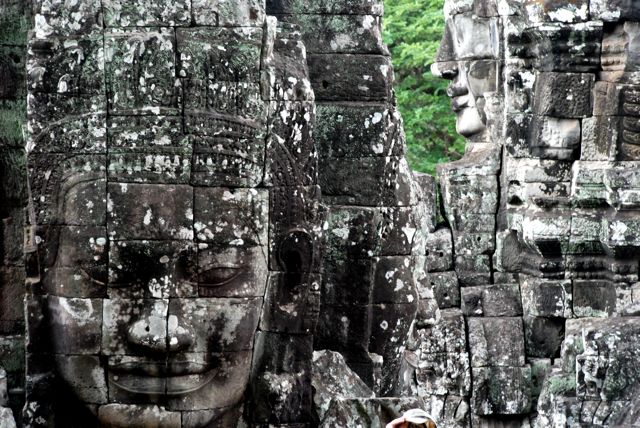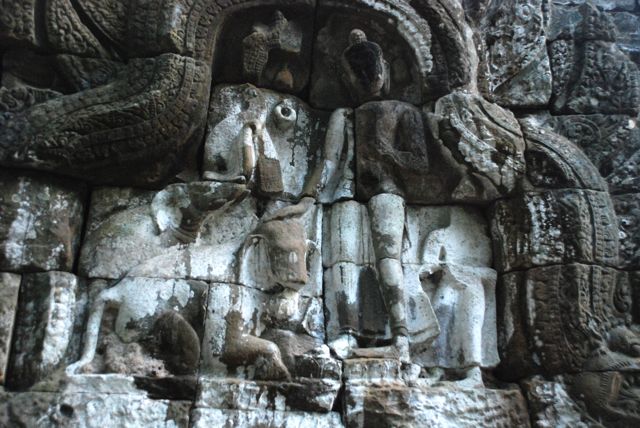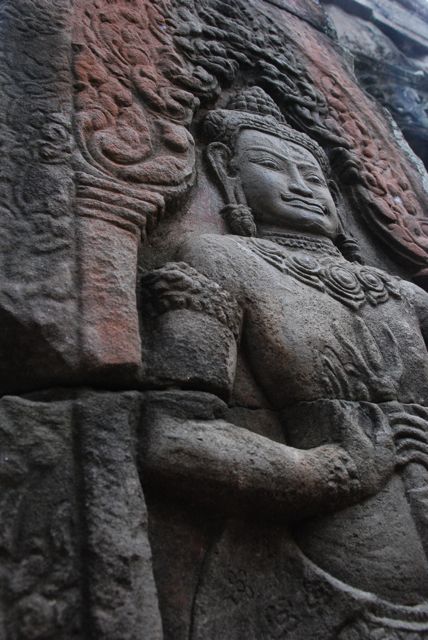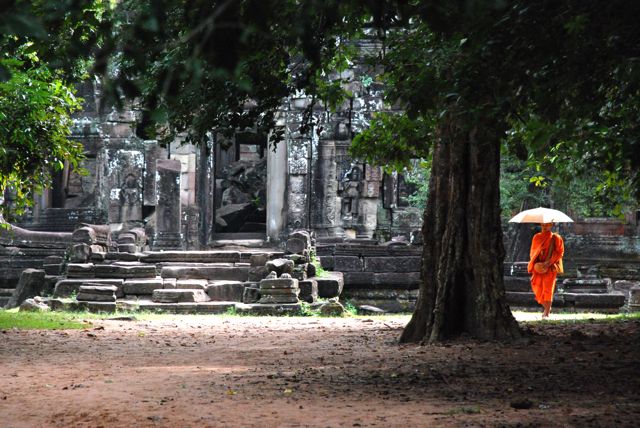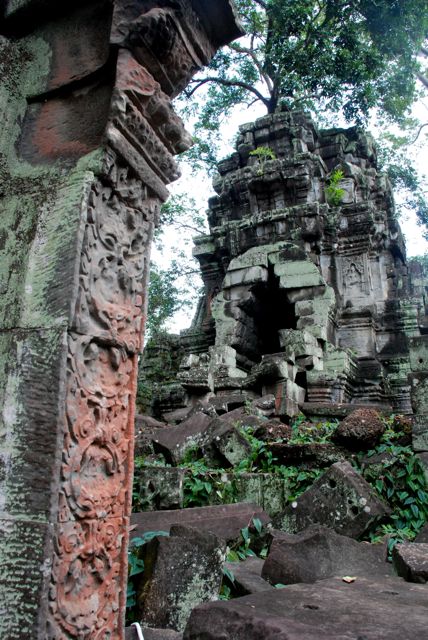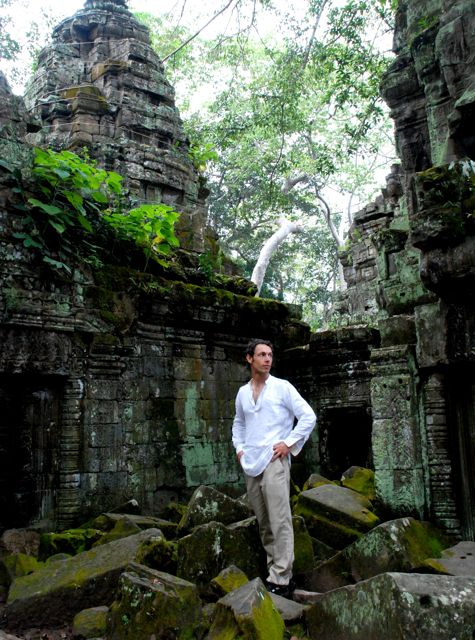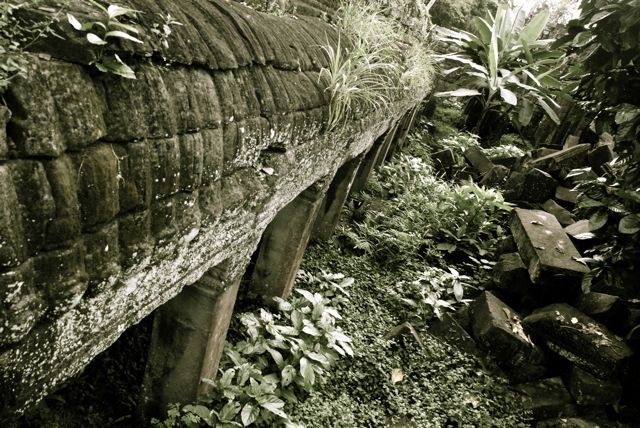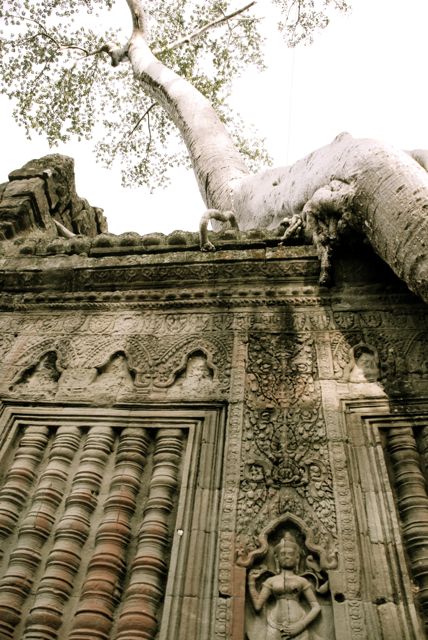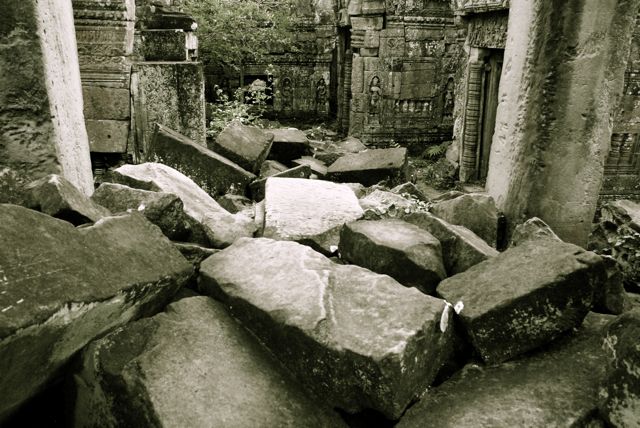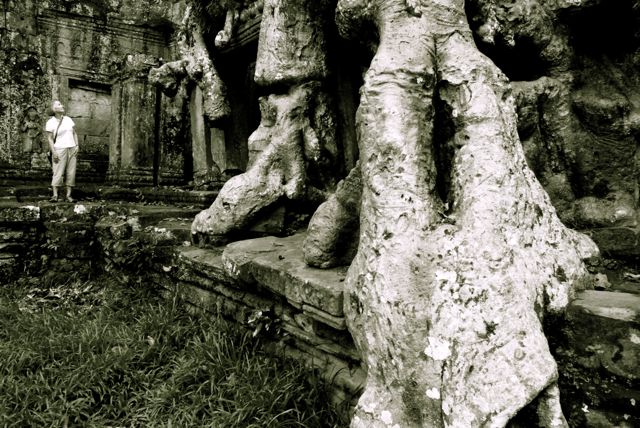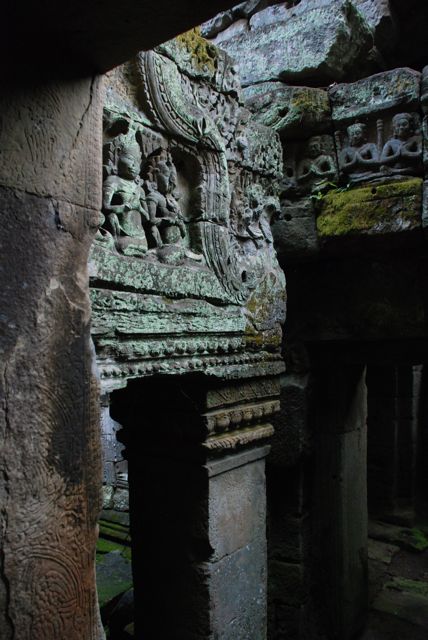Arrived in Siem Reap – flew over a vast delta of rivers and floating villages here and there amongst the glinting waters of the Cambodian plain. Into Siem Reap and immediately errant chickens on the side of the road and bicycles bring me back into South-East Asian life. Walked down the river into down town – photographic exhibition along the river, and French-style street lanterns and wide boulevards and thickly trunked rainforest trees. Loping Cambodian elders out taking the evening air. Young boys doing wheelies on their bikes. The traffic barking and stuttering forward. Finally out of the arid and empty streets of first world suburbia, and back into vibrant and energizing street scenes. Walked through the middle of town and it is widely spaced streets with arched entrances into open air restos and markets and sauntering Europeans in the warm nights air, and a feeling that, who would want to be in Europe when you could be here? Went for a massage and emerged from the spa a new and calmed being. So much for culture shock. It only lasted for about 30 mins.
This morning walking into Pra Thom – seeing the moss covered 1000 year old stone temple in the jungle, Indiana Jones-style, quiet and contemplative however, intriguing and mysterious… The old stones reared up with ineluctable beauty and dignity, framed by hundred year old thickly trunked trees. It came as a shock to the vision and the emotions: just how sacred this place feels. As soon as I arrived I felt like I wanted to savour every moment. Stop and hold and treasure each passing moment of time, with the moss and the quiet and the ancient stones, like I was walking into a cathedral and was suddenly a devout believer. The faces of the Buddha on the entrance towers as one passes over the threshold into the into the sanctuary, the secret revealed-feeling that one had as one stepped into the enclosure of the inner temple, vines and leaves and shadows and bird song embroidering the stones, some jumbled in piles, most standing tall and timeless. One wanted to feast on this experience of early morning calm and a secret of a green and sacred place, a place unfolding its petals to pupil-dilated eyes.
Then walking around the Bayon yesterday afternoon amongst the tall face towers. Grey masonry, smiling faces that see all, contain all contentment and wisdom in their expressions, far above us in space, beyond us in time.
Watched people are nice people. If you don’t believe me read Ara Norenzayan’s book Big Gods: How Religion Transformed Cooperation and Conflict (2013). Once hunter-gathers had gods but they did not have a large role in regulating moral behaviour. Then came larger scale societies were for the first time people lived together with large numbers of strangers. What would stop them stealing and robbing their neighours? Certainly not modern police forces or courts of law. Dire punishments for transgressions existed in ancient Angkor, but there were also Big Gods. Powerful, omniscient deities have had a role in regulating moral behaviour in civilization over the past few thousand years. People felt they were watched by Big Gods, even when nobody else was looking. Watched people are nice people, as various experiments in social psychology have recently shown. And it seems to me that the Bayan face towers of the Buddha at Angkor Thom are the perfect example of monuments to this aspect of human psychology and the history of civilization.
Another bit of history in stone at Angkor speaks to me powerfully. It is this…
This is the Buddha subduing Nalagiri the enraged elephant. American social psychologist Jonathan Haidt has a metaphor – which he elaborated in his 2006 book The Happiness Hypothesis – of human identity as made up of a rider and an elephant. The rider is the conscious, linguistic, reasoning self, and the elephant is the unconscious, preverbal self made up of emotions and other aspects of the self that we fail to understand. The elephant often leans one way or the other and the rider then gives a post-hoc justification for why they’ve ended up where they have. The funny thing is that the rider (acting as a kind of inner lawyer) and the elephant don’t know that this is what is going on. The rider honestly believes its post-hoc justifications most of the time. When I looked at this stone frieze I knew that the ancient Khmer understood the divided self in a sophisticated way. The rage of the elephant can only be tamed by emotional awareness and daily meditation on compassion and love. This is what the Buddha represents to me when I look at this carving.
The next morning Angkor Wat. Realized that this is the most awesome monument in Asia but much less delightful than some of the smaller and less visited temple ruins amongst the forest. Its grandiosity says, yes, I am the centre of the universe, worship here. Looking into the face of a Buddha at the centre of the temple at the top of a tower with further rooms and recesses above and behind it, you glimpse how overwhelmingly powerful the sense of significance and grandeur of this jewel of human civilization would have been to the people who lived here a millenium ago. And its nice to be reminded that the world has such high-water marks of human experience in it.
But my final word on Angkor Wat is that it does not beguile and enchant the visitor like some of the smaller and more jungle-wrapped temples of the Angkorian civilization.
Come to Siem Reap. (But don’t worry too much about Angkor Wat.) Explore this area. This is a base to see what was the largest city on earth before London grew big a couple of hundred years ago. If you live in the Asia-Pacific region and care about history and a sense of the sacred this is the place to be.
The Present at Angkor
Shadows of the tower pass over the flagstones
Vines sway, stone warms, cicadas buzz
Dove lands on a stone ledge of the central tower of Ankgor Wat
Small green tendril unfolds on this ledge
A century passes
Dove lands on a stone ledge of the tower
At the centre of the Khmer universe
A human life grows up, thrives and tires and ages and passes
The sunrise falls across the earth
The sunset falls on the other side
The earth turns, into and out of the light of a star
Bathing its people, its personalities, its insects, its stones and rivers
Day, night, day, century, millenium
Humans stand up tall two million years ago and laugh and smile and cry and run
Ten thousand years ago the wandering tribes construct the story of civilization
While the earth turns into, and out of the light of a star
The Buddha at the top of the central tower of Angkor Wat smiles
Behind the smile
Darkness and mystery
The earth spins, the centuries pass,
all psycholgy repeated anew each day, each human story
Constructed and unwoven
A city thrives, ox heaves, lovers sigh, carvers carve
A millenium later I stand
And look up at a dove landing on a stone ledge
on the central tower of Angkor Wat
Behind the Buddha’s smile
The earth spins
Centuries pass
We all move into and out of the light of a star
And the towers of Ankgor Wat spin around
The smile of a stone God.
